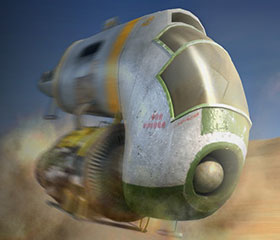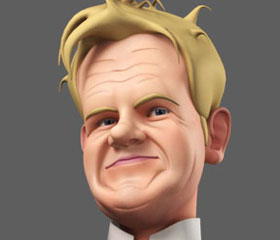From a rough artist's impression to the polished animation airing on ITV this spring, find out how the clever CG team at VFX house Red Vision created their star-spangled world at breakneck speed.
We take a look behind the scenes of this television production and catch up with talented modeler Jason Edwards to chat about the production where he worked side by side with character designer Mark Reeve bringing caricature versions of politicians and celebrities to life.
Learn more about how character models are created in a production environment inside Maya in this latest SimplyMaya feature.
 © Red Vision/ ITV
© Red Vision/ ITVThe Production Team
All the CG work for Headcases was created by Red Vision, a VFX house, with one studio in Manchester and the other in London sharing the workload. I got taken on for the Headcases production as a freelancer and it was probably the most fun I've ever had on any single project so far. Airing on ITV as we speak, this comedy show making fun at politicians and pop stars who are in the media spotlight was right up my street, Jason Edwards says with a big smile on his face.
No one project is the same, as some can be quite frustrating and others more technical, but this was one of the fun ones to do. The whole studio was in fits of laughter throughout the day while we were making it.
The whole concept of the series came about because the director Henry Naller wanted to update an old series from the 80's called "Spitting Image" which at the time had the caricatures crafted from latex and foam so they had limitations of only being operated from the hips upwards, a bit like "The Muppets". It was the job of the hard-working production team to bring it all up to date and create everything entirely in CG.

© Red Vision / ITV
As with most productions we had two concept guys on the project, Mark Reeve and Warren Osbourne. Mark was actually a character artist on the original "Spitting Image" show and he was brought in to do the character design and concepts in the London Studio, whereas Warren was designing environments in the Manchester Studio.
Jay mentions that with a full-time character designer working on the production he didn't have to worry about creating his own drawings for the characters, but that he's always done at least one sketch for everything else he's ever built before Headcases, both in his personal and professional work.

© Red Vision / ITV
I'm one of those people who likes a visual guide to work from, I think most modelers are, he says. It can help iron out problems early on even before the actual modeling process starts in Maya.
I speak to 3D modelers here and there and there's always one that says they don't do any drawings before they model, some people can't draw, but I'd always say it doesn't hurt to doodle an idea or prepare by looking up some form of reference.
You wouldn't build a house without a plan would you? Concepts, designs and reference are absolutely critical, not just to the modeler but to the 3D artist as a whole.
Production Workflow
I was based in the London Studio, and I was the only character modeler there, most of the other guys were animators or FX guys. Actually I was initially brought on board to help the character designer 'fix' the characters that were sent from the Manchester studio to London for approval.
Anything that didn't resemble the concept art was given to me for correcting. There were a few messy meshes to deal with, I'm very particular with my meshes, and I must admit to sounding off after receiving a model with a 9 sided poly on it, I was not impressed.
After about a week I think there was a realization that I was actually pretty good and from then on I was given full characters to build, plus still correcting the stuff coming in from Manchester.
On a daily basis I would pretty much model the characters for the show, while there were four others building them in Manchester. It was interesting as they would have to send the finished models down to Mark to sign off.
He was very thorough in his design and if anything was out of place, it was no go, and I would correct them with Mark over my shoulder checking the design while I worried about topology.
I have to say I was a little bit surprised at some of the geometry we were getting, it was a little messy.

© Red Vision / ITV
I was lucky as I had the character designer in the same studio, so if I had a problem with his sketches I could have him explain it or adjust it straight away without the back and forth.

© Red Vision / ITV
I managed to build up my own library of body parts in order to speed the process up as well and this was basically due to the fact that the show was of a certain style so there wasn't a real need to keep making limbs over and over or clothing unless it was absolutely necessary.
Usually though, the character models would take around 3 - 4 days max depending on the design, I would then UV them for texturing, then in turn they would go off for rigging to be readied for animation.

© Red Vision / ITV
It was a pretty straight forward process. One of the TD's came up with a great way of doing facial expressions with five wrap deformers and a handful of phoneme expressions - it needed to be done like this because we had so many characters and had we stuck to the more traditional way we would never have finished in time for the deadline.
Production Characters
We ask Jay about the main things to think about when capturing personality in a character model.
Overall creating the caricatures for Headcases didn't really pose a great deal of problems for me personally, he recalls. Though I do remember making the model of Amy Winehouse and getting it signed off only having to revisit it a day after because she had gone and changed her hairstyle from a black beehive style to a cropped blonde with a headscarf.
But that's a celebrity for you! he says laughing a bit.
I think the more extreme the caricatures were in their looks the easier they were to do because the characteristics are so clear you can just see what you have to do and go for it, the Amy Winehouse model is a prime example of this as opposed to the model I remade of Katie Holmes and she was so hard to do, I think it took five goes before we were happy with it.
Although she has a nice face with big brown eyes and a button nose, she is actually very plain overall and that's what made it hard to do, she has no immediately striking features to exaggerate, whereas Madonna and Amy Winehouse have so much character they are actually very easy to do.

© Red Vision / ITV
It's a combination of both the person's charisma as well as their looks. For a character like Chef Ramsay which I created for SimplyMaya just after we wrapped up the production on Headcases has a very weathered face with lots of features and his personality is well....you know, fiery! So I think when you know a bit about a person and how they are it makes life a little easier to create them.
Learn more about creating production standard characters in Maya:
Industry Insights: Senior VFX Modeler

An Interview with Jason Edwards about working in the VFX industry in London for the past 15 years on feature films and tv productions. More...

Get a more detailed look at the workflow for modeling specific characters like the ones in Headcases. More...

Get ten hours of top notch production character training and start building your own characters for animation inside Maya. More...